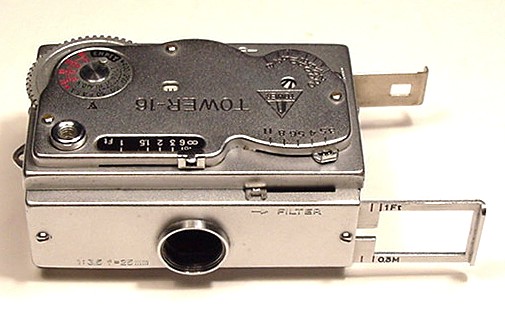
Sears Roebuck Tower 16 Camera
The Tower 16 camera was sold by Sears Roebuck and Company, and manufactured by Mamiya Camera Company of Tokyo, Japan. The Tower 16 is identical to the Mamiya-16 Super subminiature camera except for the name. The Tower 16 is less common than the Mamiya version.
The Mamiya-16 Super was manufactured in the early 1950s. Various sources appear to disagree as to the exact date of manufacture, and furthermore they disagree on variations within the Super 16 model line.

A true subminiature camera, the Tower 16 uses special cassettes for up to 20 exposures on 16mm film. The image size is 10 x 14 mm. The lens is a 25mm f/3.5 with aperture adjustable to f/11. The shutter is synchronized for flash and adjustable from 1/2 to 1/200 second plus bulb. The viewfinder is a simple metal frame that retracts into the body when not in use. The camera focuses as close as 1 foot or .3 meter. There is no rangefinder however, so distance needs to be measured or estimated. The lack of a rangefinder is not a big drawback because the lens has a large depth of field. Only close distances require measurement.
An interesting detail of the viewfinder is a parallax mark at the 1 foot distance. There is also a built-in yellow filter that can be slid in front of the lens as in Minox cameras.
The Mamiya-16 Super in my collection is identical in features to the Tower 16 camera sold by Sears Roebuck and Company. The only apparent differences are the engravings of the model name, and the lens name that is engraved on the Mamiya camera: "Cute" (yes, that is the name). The Tower camera does not have this engraving. However, both lenses are shown as 25mm f/3.5 optics.
If you have one of these cameras, and you have wound the advance wheel, but the shutter does not fire, pull out the viewfinder frame. The shutter is locked when the viewfinder is retracted to prevent accidental exposures when carrying the camera.
One other nice feature of this camera - notice a circular cutout below the triangular Tower logo engraving on the top cover. Inside the cutout are radiating black and white lines. When the film is advanced, the lines spin to indicate that the film is advancing properly.

|
Page created October, 2001;
updated December 20, 2020 |